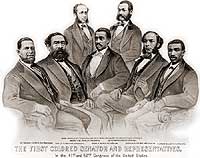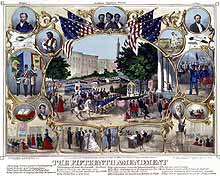35b. Radical Reconstruction
The Radical Republicans believed blacks were entitled to the same political rights and opportunities as whites. They also believed that the Confederate leaders should be punished for their roles in the Civil War. Leaders like Pennsylvania Representative Thaddeus Stevens and Massachusetts Senator Charles Sumner vigorously opposed Andrew Johnson's lenient policies. A great political battle was about to unfold.
Americans had long been suspicious of the federal government playing too large a role in the affairs of state. But the Radicals felt that extraordinary times called for direct intervention in state affairs and laws designed to protect the emancipated blacks. At the heart of their beliefs was the notion that blacks must be given a chance to compete in a free-labor economy. In 1866, this activist Congress also introduced a bill to extend the life of the Freedmen's Bureau and began work on a Civil Rights Bill.

Hiram Revels of Mississippi was elected Senator and six other African Americans were elected as Congressmen from other southern states during the Reconstruction era.
President Johnson stood in opposition. He vetoed the Freedmen's Bureau Bill, claiming that it would bloat the size of government. He vetoed the Civil Rights Bill rejecting that blacks have the "same rights of property and person" as whites.
Moderate Republicans were appalled at Johnson's racism. They joined with the Radicals to overturn Johnson's Civil Rights Act veto. This marked the first time in history that a major piece of legislation was overturned. The Radicals hoped that the Civil Rights Act would lead to an active federal judiciary with courts enforcing rights.
Congress then turned its attention to amending the Constitution. In 1867 they approved the far-reaching Fourteenth Amendment, which prohibited "states from abridging equality before the law." The second part of the Amendment provided for a reduction of a state's representatives if suffrage was denied. Republicans, in essence, offered the South a choice — accept black enfranchisement or lose congressional representation. A third clause barred ex-Confederates from holding state or national office.
Emboldened by the work of the Fourteenth Amendment and by local political victories in the 1866 elections, the Republicans went on to introduce the Reconstruction Act of 1867. This removed the right to vote and seek office by "leading rebels." Now the Southern Unionists — Southerners who supported the Union during the War — became the new Southern leadership. The Reconstruction Act also divided the South into five military districts under commanders empowered to employ the army to protect black property and citizens.
The first two years of Congressional Reconstruction saw Southern states rewrite their Constitutions and the ratification of the Fourteenth Amendment. Congress seemed fully in control. One thing stood in the way — it was President Johnson himself. Radical leaders employed an extraordinary Constitutional remedy to clear the impediment — Presidential impeachment.





